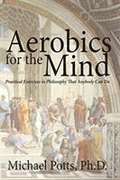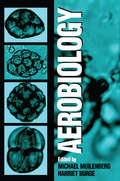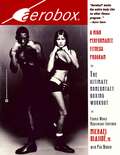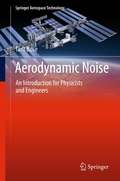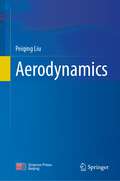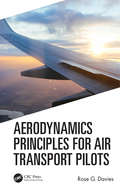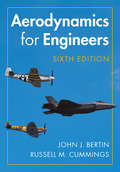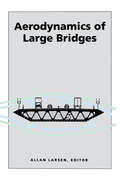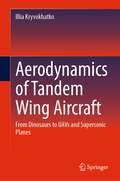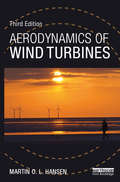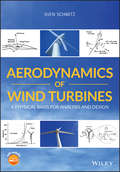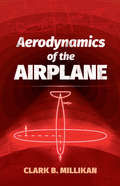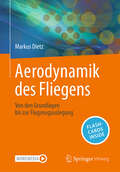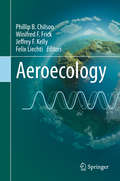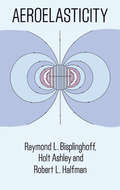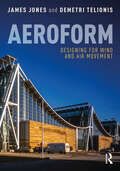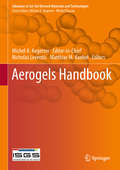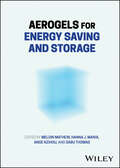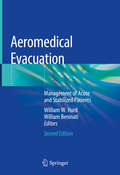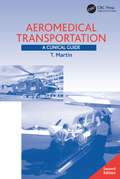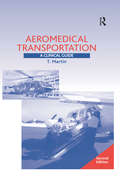- Table View
- List View
Aerobics for the Mind: Practical Exercises in Philosophy that Anybody Can Do
by Michael PottsRemember when you were a child and incessantly asked your parents "Why?" You still had that childhood gift of wondering about everything from the simple "Why can't I touch the stove eye when it's red?" to the most profound questions people can ask "Why can't I see God if He's real?" <p> A common perception of philosophers is of the wizened old guru, sitting on a mountain top contemplating his navel; or worse, a stodgy, boring intellectual that everyone avoids at parties. But philosophy, at its best, is a joyous profession. Philosophers never stop wondering, why? They ask the most profound and universal questions: "Why am I here?" "Does life have a meaning?" "Is there a God?" "Do I have an immortal soul?" "What happens when I die?" Philosophers have the joy of re-living the wonder of a child. <p> Aerobics for the Mind: Practical Exercises in Philosophy that Anybody Can Do is a book for anyone who still has that unique, childlike sense of wonder.
Aerobiology
by Michael L. Muilenberg Harriet A. BurgeAerobiology is the study of airborne particles that have an impact on humans and other organisms. Every day, we are exposed to airborne particles, including "natural" particles such as pollen, bacteria, and fungi, and "unnatural" particles, such as asbestos fibers and noxious chemicals. Aerobiology highlights the current interests in this field, primarily the ecology and distribution of airborne particles and their effects on health.
Aerobox: A High Performance Fitness Program
by Michael Olajide Jr.Designed by a former world-class middleweight boxer, here is the fitness crossover sensation of the '90s--a cardiovascular and toning exercise program that channels the aerobic intensity of a boxer's workout into an exhilarating non-contact fitness program.
Aerodynamic Noise: An Introduction for Physicists and Engineers (Springer Aerospace Technology #7)
by Tarit BoseAerodynamic Noise extensively covers the theoretical basis and mathematical modeling of sound, especially the undesirable sounds produced by aircraft. This noise could come from an aircraft's engine--propellers, fans, combustion chamber, jets--or the vehicle itself--external surfaces--or from sonic booms. The majority of the sound produced is due to the motion of air and its interaction with solid boundaries, and this is the main discussion of the book. With problem sets at the end of each chapter, Aerodynamic Noise is ideal for graduate students of mechanical and aerospace engineering. It may also be useful for designers of cars, trains, and wind turbines.
Aerodynamic and Aerothermodynamic Analysis of Space Mission Vehicles
by Antonio Viviani Giuseppe PezzellaPresenting an up-to-date view on the most important space vehicle configurations, this book contains detailed analyses for several different type of space mission profiles while considering important factors such as aerodynamic loads, aerodynamic heating, vehicle stability and landing characteristics. With that in mind, the authors provide a detailed overview on different state-of-the-art themes of hypersonic aerodynamics and aerothermodynamics, and consider different space vehicle shapes useful for different space mission objectives. These include: #65533; Crew Return Vehicle (CRV) #65533; Crew Exploration Vehicle (CEV) #65533; Sample Return Vehicle (SRV) #65533; Flying Test Bed (FTB). Throughout Aerodynamic and Aerothermodynamic Analysis of Space Mission Vehicles many examples are given, with detailed computations and results for the aerodynamics and aerothermodynamics of all such configurations. Moreover, a final chapter on future launchers is provided and an Appendix on a possible manned mission to Mars closes the book. This work can be used as a reference for modelling and design techniques, for students intending to enter aerospace industrial careers, and to support both academics and engineers working in the field of space vehicle design. This book has been awarded the Basic Science Book award 2016 by the International Academy of Astronautics (IAA), presented during the 67th International Astronautical Congress (IAC2016) held in September 2016 in Guadalajara, Mexico.
Aerodynamics
by Peiqing LiuThis textbook highlights the fundamentals of aerodynamics and the applications in aeronautics. The textbook is divided into two parts: basic aerodynamics and applied aerodynamics. The first part focuses on the basic principles and methods of aerodynamics. The second part covers the aerodynamic characteristics of aircraft in low speed, subsonic, transonic and supersonic flows. The combination of the two parts aims to cultivate students' aerospace awareness, build the ability to raise and solve problems and the ability to make comprehensive use of the knowledge to carry out innovative practice. This book is intended for undergraduates majoring in aircraft design and engineering, engineering mechanics, flight mechanics, missile design, etc. It can also be used as a reference for postgraduates, researchers and engineers of aerospace related majors.
Aerodynamics Principles for Air Transport Pilots
by Rose G DaviesEquipping readers with the ability to analyze the aerodynamic forces on an aircraft, the book provides comprehensive knowledge of the characteristics of subsonic and supersonic airflow. This book begins with the fundamental physics principles of aerodynamics, then introduces the Continuity Equation, Energy Equations, and Bernoulli’s Equation, which form the basic aerodynamic principles for subsonic airflow. It provides a thorough understanding of the forces acting on an aircraft across a range of speeds and their effects on the aircraft's performance, including a discussion on the difference in aerofoil and aircraft shapes. Aircraft stability issues are analyzed, along with the development of a boundary layer over an aerofoil, the changes of air speed and air pressure, and boundary layer separation. Readers will gain a clear understanding of the nature of airflow over aircraft during subsonic, transonic, and supersonic flight. The book emphasizes the connection between operating actions in flight and aerodynamic requirements. The content will be of interest to senior undergraduates studying to obtain their Airline Transport Pilot License (ATPL)/Airline Transport Pilot (ATP) certificate, general aviation and air transport pilots, and aircraft maintenance engineers.
Aerodynamics for Engineers
by Russell M. Cummings John J. BertinNow reissued by Cambridge University Press, this sixth edition covers the fundamentals of aerodynamics using clear explanations and real-world examples. Aerodynamics concept boxes throughout showcase real-world applications, chapter objectives provide readers with a better understanding of the goal of each chapter and highlight the key 'take-home' concepts, and example problems aid understanding of how to apply core concepts. Coverage also includes the importance of aerodynamics to aircraft performance, applications of potential flow theory to aerodynamics, high-lift military airfoils, subsonic compressible transformations, and the distinguishing characteristics of hypersonic flow. Supported online by a solutions manual for instructors, MATLAB® files for example problems, and lecture slides for most chapters, this is an ideal textbook for undergraduates taking introductory courses in aerodynamics, and for graduates taking preparatory courses in aerodynamics before progressing to more advanced study.
Aerodynamics of Large Bridges: Proceedings Of The First International Symposium On Aerodynamics Of Large Bridges, Copenhagen, Denmark, 19-21 February 1992
by ALLAN LARSEN, DANISH MARITIME INSTITUTEAs bridges spans get longer, lighter and more slender, aerodynamic loads become a matter of serious study. This volume of proceedings reflect the co-operation between civil and mechanical engineering and meteorology in this field.
Aerodynamics of Tandem Wing Aircraft: From Dinosaurs to UAVs and Supersonic Planes
by Illia KryvokhatkoThis book contains extensive data about tandem wing aircraft. It includes a review of modern flying vehicles with four fixed wings, a review of analytical, numerical and experimental methods; results of the studies about aerodynamics; dependencies between geometrical parameters and aerodynamic characteristics, practical recommendations in development and optimizing of tandem wing aircraft to provide high lift-to-drag ratio, stability, and controllability. This is an ideal book for graduate students, researchers, and engineers working in fields of aerodynamics and conceptual design of the aircraft especially UAVs, ground-effect vehicles, and convertiplanes.
Aerodynamics of Tandem Wing Aircraft: From Dinosaurs to UAVs and Supersonic Planes
by Illia S. KryvokhatkoThis updated, second edition adds more reviews of modern four-winged aircraft belonging to convertiplanes, Medium Altitude Long Endurance UAVs, and solar planes. As in the first edition, different analytical, numerical, and experimental methods are discussed in detail. The book presents new sections on unsteady aerodynamic characteristics of tandem wings and specifics of their aerodynamic loading for stress analysis and structural design. Also, dependencies between key geometric parameters and aerodynamic characteristics were updated with new studies that helped to understand the physics more deeply and even reinterpret previous experimental results. Accordingly, practical recommendations in development and optimizing of tandem wing aircraft were updated to provide high endurance, wide range of flight velocities, stability, and controllability. This is an ideal book for graduate students, researchers, and engineers working in fields of aerodynamics and conceptual design of the aircraft especially UAVs and light piloted airplanes.
Aerodynamics of Wind Turbines
by Martin O. HansenAerodynamics of Wind Turbines is the established essential text for the fundamental solutions to efficient wind turbine design. Now in its third edition, it has been substantially updated with respect to structural dynamics and control. The new control chapter now includes details on how to design a classical pitch and torque regulator to control rotational speed and power, while the section on structural dynamics has been extended with a simplified mechanical system explaining the phenomena of forward and backward whirling modes. Readers will also benefit from a new chapter on Vertical Axis Wind Turbines (VAWT). Topics covered include increasing mass flow through the turbine, performance at low and high wind speeds, assessment of the extreme conditions under which the turbine will perform and the theory for calculating the lifetime of the turbine. The classical Blade Element Momentum method is also covered, as are eigenmodes and the dynamic behaviour of a turbine. The book describes the effects of the dynamics and how this can be modelled in an aeroelastic code, which is widely used in the design and verification of modern wind turbines. Furthermore, it examines how to calculate the vibration of the whole construction, as well as the time varying loads and global case studies.
Aerodynamics of Wind Turbines: A Physical Basis for Analysis and Design
by Sven SchmitzA review of the aerodynamics, design and analysis, and optimization of wind turbines, combined with the author’s unique software Aerodynamics of Wind Turbines is a comprehensive introduction to the aerodynamics, scaled design and analysis, and optimization of horizontal-axis wind turbines. The author –a noted expert on the topic – reviews the fundamentals and basic physics of wind turbines operating in the atmospheric boundary layer. He then explores more complex models that help in the aerodynamic analysis and design of turbine models. The text contains unique chapters on blade element momentum theory, airfoil aerodynamics, rotational augmentation, vortex-wake methods, actuator-line modeling, and designing aerodynamically scaled turbines for model-scale experiments. The author clearly demonstrates how effective analysis and design principles can be used in a wide variety of applications and operating conditions. The book integrates the easy-to-use, hands-on XTurb design and analysis software that is available on a companion website for facilitating individual analyses and future studies. This component enhances the learning experience and helps with a deeper and more complete understanding of the subject matter. This important book: Covers aerodynamics, design and analysis and optimization of wind turbines Offers the author’s XTurb design and analysis software that is available on a companion website for individual analyses and future studies Includes unique chapters on blade element momentum theory, airfoil aerodynamics, rotational augmentation, vortex-wake methods, actuator-line modeling, and designing aerodynamically scaled turbines for model-scale experiments Demonstrates how design principles can be applied to a variety of applications and operating conditions Written for senior undergraduate and graduate students in wind energy as well as practicing engineers and scientists, Aerodynamics of Wind Turbines is an authoritative text that offers a guide to the fundamental principles, design and analysis of wind turbines.
Aerodynamics of the Airplane (Dover Books on Aeronautical Engineering)
by Clark B. MillikanWritten on the eve of World War II, this brief but intensive introduction by one of the founders of the Jet Propulsion Laboratory deals with the basic problems of aerodynamics. 1941 edition.
Aerodynamik axialer Turbokompressoren
by Franz JoosDieses Fachbuch gibt einen fundierten Einblick in die mehrdimensionale Aerodynamik von Turbokompressoren anhand aktueller Designmerkmale sowie deren physikalischer Grundlagen. Zur Effizienzsteigerung von Gasturbinen und Industriekompressoren werden die Beschaufelungen mehrdimensional ausgelegt.
Aerodynamik des Fliegens: Von den Grundlagen bis zur Flugzeugauslegung
by Markus DietzSie interessieren sich für die Aerodynamik von Flugzeugen, und Ihr Interesse geht über die populärwissenschaftliche Darstellung hinaus? Gleichungen schrecken Sie nicht ab, denn Sie verfügen über mathematische und physikalische Kenntnisse aus einem technischen Studium? Dann bietet Ihnen dieses Lehrbuch einen umfassenden Überblick über die Flugzeugaerodynamik von den strömungsmechanischen und aerodynamischen Grundlagen bis hin zur Flugzeugauslegung. Das Werk erfordert über ein mathematisch-physikalisches Grundwissen hinaus keine Vorkenntnisse. Nach dem Studium des Buches verfügen Sie über ein solides Wissen zur Aerodynamik von Profilen und Tragflügeln und verstehen die unterschiedliche aerodynamische Auslegung verschiedener Flugzeugtypen wie Segelflugzeuge, Kleinflugzeuge, Verkehrsflugzeuge und überschallschnelle Kampfflugzeuge.Weil das Werk auch auf die Grundlagen der Flugmechanik und Flugleistungsrechnung eingeht, eignet es sich auch als Begleitwerk für ein Luftfahrttechnik-Studium, um einerseits den Blick „aufs Wesentliche“ nicht zu verlieren und zum anderen, um die Verknüpfungen zwischen den Disziplinen Strömungsmechanik, Aerodynamik, Flugmechanik und Flugzeugauslegung besser zu verstehen. Auch auf fliegerische Aspekte wird an vielen Stellen eingegangen, beispielsweise auf den Zusammenhang zwischen der aerodynamischen Gestaltung des Flugzeugs und seinen Flugeigenschaften, den Aufbau der Atmosphäre und die Definition der „Airspeeds“ und deren Umrechnung. Damit stellt das Buch auch für Berufs- und Hobbypiloten eine sinnvolle Ergänzung dar. Abgerundet wird das Werk durch einige Informationen zu den relevanten historischen Persönlichkeiten und Meilensteinen der Luftfahrt.Am Ende der meisten Kapitel befinden sich Übungsaufgaben, die so gestalten wurden, dass das Erlernte vertieft wird. Eine kurze Zusammenfassung des nötigen mathematischen und thermodynamischen Handwerkszeugs findet sich im Anhang des Buchs.Zusätzliche Fragen per App: Zur Überprüfung des Lernerfolgs stehen insgesamt 170 Flashcards-Fragen bereit. Laden Sie die Springer-Nature-Flashcards-App kostenlos herunter und nutzen Sie exklusives Zusatzmaterial, um Ihr Wissen zu prüfen.
Aeroecology
by Phillip B. Chilson Winifred F. Frick Jeffrey F. Kelly Felix LiechtiThis book consists of a diverse collection of chapters that seeks to broaden our fundamental understanding of the ecological function and biological importance of the Earth’s lower atmosphere, which provides a huge living space for billions of animals moving within and across continents. <P><P>Their migration, dispersal and foraging activities connect water and land habitats within and across continents. Drawing upon the wide-ranging experience of the authors, the book takes an inherently interdisciplinary approach that serves to introduce the reader to the topic of aeroecology, frame some of the basic biological questions that can be addressed within the context of aeroecology, and highlight several existing and emerging technologies that are being used to promote aeroecological studies. The book begins with several background chapters, that provide introduction into such topics as atmospheric science, the concept of the habitat, animal physiology, and methods of navigation. It then continues with a broad discussion of observational methods available to and used by aeroecologists. Finally, several targeted examples of aeroecological studies are presented. <P><P>Following the development of the chapters, the reader is provided with a unifying framework for investigating how the dynamic properties of meteorological conditions at local, regional, and global scales affect the organisms that depend on the air for foraging and movement. Material presented in the book should be of interest to anyone wishing to gain a comprehensive understanding of the aerosphere itself and the myriad airborne organisms that inhabit and depend upon this environment for their existence. The material should be accessible to a diverse set of readers at all stages of training and across a range of research expertise.
Aeroelasticity (Dover Books on Aeronautical Engineering)
by Holt Ashley Robert L. Halfman Raymond L. BisplinghoffDesigned as both a textbook for advanced engineering students and a reference book for practicing engineers, this highly regarded work deals not only with the practical aspects of aeroelasticity, but the aerodynamic and structural tools upon which these rest. Accordingly, the book divides roughly into two halves: the first deals with the tools and the second with applications of the tools to aeroelastic phenomena.Topics include deformation of airplane structures under static and dynamic loads, approximate methods of computing natural mode shapes and frequencies, two-and three-dimensional incompressible flow, compressible flow, wings and bodies in three-dimensional unsteady flow, static aeroelastic phenomena, flutter, dynamic response phenomena, aeroelastic model theory, model design and construction, testing techniques and more. Chapters have been designed to progress from easy to difficult so that instructors using this book as an elementary text in aeroelasticity will find their purposes served by simply using the first parts of selected chapters.Helpful appendixes deal with such mathematical tools as matrices and linear systems (prerequisites include the usual engineering mathematics courses and advanced calculus), while many numerical examples are included throughout the text. Engineering students as well as practicing engineers will find this work an unmatched treatment of the topic and an indispensable reference for their libraries.
Aeroform: Designing for Wind and Air Movement
by James Jones Demetri TelionisAeroform: Designing for Wind and Air Movement provides a comprehensive introduction to applying aerodynamic principles to architectural design. It presents a challenge to architects and architectural engineers to give shape to the wind and express its influence on architectural form. The wind pushes and pulls on our buildings, infiltrates and exfiltrates through cracks and openings, and lifts roofs during storm events. It can also offer opportunities for resource conservation through natural ventilation or a biophilic connection between indoors and out. This book provides basic concepts in fluid mechanics such as materials, forces, equilibrium, pressure, and hydrostatics; introduces the reader to the concept of airflow; and provides strategies for designing for wind resistance, especially in preventing uplift. Natural ventilation and forced airflow are explored using examples such as Thomas Herzog’s Hall 26 in Hanover, RWE Ag building in Essen Germany, and the Kimbell Art Museum in Texas. Finally, issues of wind and airflow measurement are addressed. A reference for students and practitioners of architecture and architectural engineering, this book is richly illustrated and presents complex concepts of aerodynamic engineering in easy-to-understand language. It prepares the architect or architectural engineer to design buildings that are visually expressive of a dialogue between wind and built form.
Aerogels Handbook (Advances in Sol-Gel Derived Materials and Technologies)
by Michel Andre Aegerter Matthias M. Koebel Nicholas LeventisAerogels are the lightest solids known. Up to 1000 times lighter than glass and with a density as low as only four times that of air, they show very high thermal, electrical and acoustic insulation values and hold many entries in Guinness World Records. Originally based on silica, R&D efforts have extended this class of materials to non-silicate inorganic oxides, natural and synthetic organic polymers, carbon, metal and ceramic materials, etc. Composite systems involving polymer-crosslinked aerogels and interpenetrating hybrid networks have been developed and exhibit remarkable mechanical strength and flexibility. Even more exotic aerogels based on clays, chalcogenides, phosphides, quantum dots, and biopolymers such as chitosan are opening new applications for the construction, transportation, energy, defense and healthcare industries. Applications in electronics, chemistry, mechanics, engineering, energy production and storage, sensors, medicine, nanotechnology, military and aerospace, oil and gas recovery, thermal insulation and household uses are being developed with an estimated annual market growth rate of around 70% until 2015. The Aerogels Handbook summarizes state-of-the-art developments and processing of inorganic, organic, and composite aerogels, including the most important methods of synthesis, characterization as well as their typical applications and their possible market impact. Readers will find an exhaustive overview of all aerogel materials known today, their fabrication, upscaling aspects, physical and chemical properties, and most recent advances towards applications and commercial products, some of which are commercially available today. Key Features: *Edited and written by recognized worldwide leaders in the field *Appeals to a broad audience of materials scientists, chemists, and engineers in academic research and industrial R&D *Covers inorganic, organic, and composite aerogels *Describes military, aerospace, building industry, household, environmental, energy, and biomedical applications among others
Aerogels for Energy Saving and Storage
by Sabu Thomas Hanna J. Maria Ange Nzihou Meldin MathewExplore the energy storage applications of a wide variety of aerogels made from different materials In Aerogels for Energy Saving and Storage, an expert team of researchers delivers a one-stop resource covering the state-of-the-art in aerogels for energy applications. The book covers their morphology, properties, and processability and serves as a valuable resource for researchers and professionals working in materials science and environmentally friendly energy and power technology. The authors offer a comprehensive review of highly efficient energy applications of aerogels that bridges the gap between engineering, science, and chemistry and advances the field of materials development. They provide a Life Cycle Assessment of aerogels in energy systems, as well as discussions of their impact on the environment. Aerogel synthesis, characterization, fabrication, morphology, properties, energy-related applications, and simulations are all explored, and likely future research directions are provided. Readers will also find: A thorough introduction to aerogels in energy, including state-of-the-art advancements and challenges newly encountered Comprehensive explorations of chitin-based and cellulose-derived aerogels, as well as lignin-, clay-, and carbon nanotube-based aerogels Practical discussions of organic, natural, and inorganic aerogels, with further analyses of the lifecycle of aerogels In-depth examinations of the theory, modeling, and simulation of aerogels Perfect for chemical and environmental engineers, Aerogels for Energy Saving and Storage will also earn a place in the libraries of chemistry and materials science researchers in academia and industry.
Aeromedical Evacuation: Management of Acute and Stabilized Patients
by William W. Hurd William BeninatiThe definitive treatment on the medical evacuation and management of injured patients in both peace- and wartime. Edited by eminent experts in the field, this text brings together medical specialists from all four branches of the armed services. It discusses the history of aeromedical evacuation, triage and staging of the injured patient, evacuation from site of injury to medical facility, air-frame capabilities, medical capabilities in-flight, response to in-flight emergencies, and mass emergency evacuation. Specific medical conditions are addressed in detail, including such general surgical casualties as abdominal wounds and soft tissue, vascular, maxillofacial, head and spinal cord injuries, ophthalmologic, orthopaedic, pediatric, obstetric-gynecologic casualties, burns, and more. Over 80 illustrations provide a review of transport equipment and both medical and surgical treatment. A must-have reference for all armed forced physicians and flight surgeons, for general and trauma surgeons, internists, intensive care specialists, orthopaedic surgeons, and public health service physicians.
Aeromedical Psychology: Clinical Assessment And Determination Of Flight Status
by Carrie H. Kennedy Gary G. KayAeromedical psychology is that branch of psychology pertaining to the assessment, selection and evaluation of aviation personnel. This book, Aeromedical Psychology, is designed to provide the means for a variety of clinicians to carry out sound assessment and selection procedures, perform informed evaluations and make subsequent recommendations regarding flight status and treatment strategies geared to the aviation environment. To facilitate a dynamic understanding of the field, the book emphasizes an integration of applications and theory, case examples and research. The book is divided into three parts. The first presents assessment and selection procedures for aviation personnel (i.e. air traffic controllers, flight officers and pilots) and astronauts and the many ways in which both psychologists and psychiatrists are involved in these roles. In the second part, the waiver standards put forth by both the FAA and the various branches of the military are presented, as well as the waiver decision process. Clinical issues unique to aviation - notably fear of flying, motivation to fly and airsickness - are addressed, as well as possible courses of intervention, treatment and disposition. In the final part, more specialized issues pertaining to aeromedical psychology are dealt with, namely the psychopharmacological research and regulations applicable to recreational pilots and aviation personnel, managing the aftermath of aviation mishaps and the psychologist's role in accident investigations.
Aeromedical Transportation: A Clinical Guide
by T. MartinStill the only book published anywhere in the world which is devoted entirely to the principles of aeromedical transport, Aeromedical Transportation has rightly become known as the sole reference for the industry. This second edition has been radically revised and updated; featuring the latest research, updated references and new chapters on the transport of intensive care patients, and medical emergencies/death in flight. Since the first edition was published in 1996, the concept of 'evidence-based medicine' has been accepted as essential in any book which endeavours to be the accepted knowledge base in its subject area. A very practical text, international in its approach, much of its content is devoted to clinical matters. Administration and organisation are also discussed, but are addressed from the standpoint of the clinical aeromedical escort. The text is suitable for medical, paramedical and nursing personnel and for those working in organizations whose duties include the transportation of the sick and injured by air.
Aeromedical Transportation: A Clinical Guide
by Terence MartinThis book focuses on the principles of aeromedical transport and includes latest research and new chapters on the transport of intensive care patients and medical emergencies/death in flight. It is intended for medical personnel whose duties include the transportation of the sick and injured by air.
